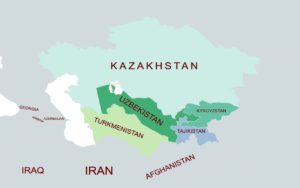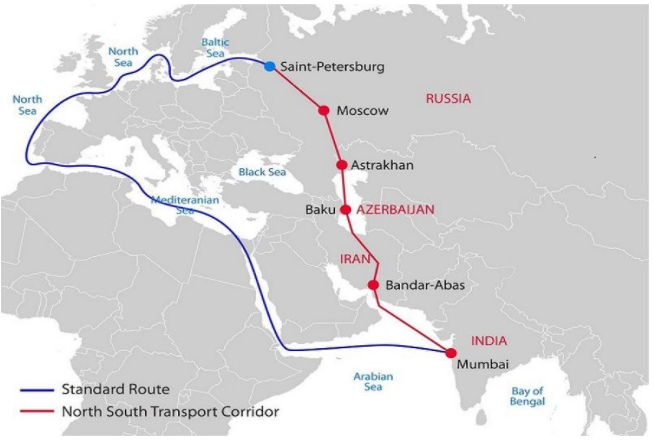ForumIAS announcing GS Foundation Program for UPSC CSE 2025-26 from 19 April. Click Here for more information.
ForumIAS Answer Writing Focus Group (AWFG) for Mains 2024 commencing from 24th June 2024. The Entrance Test for the program will be held on 28th April 2024 at 9 AM. To know more about the program visit: https://forumias.com/blog/awfg2024
Contents
- 1 Introduction
- 2 What is the extent of the Central Asian Region?
- 3 How did the India-Central Asia relations evolve over time?
- 4 What is the importance of the Central Asian region for India?
- 5 What are the initiatives undertaken to boost India-Central Asia relations?
- 6 What are the factors hindering India-Central Asia relations from reaching their true potential?
- 7 What measures can be undertaken to enhance India-Central Asia relations?
- 8 Conclusion
| For 7PM Editorial Archives click HERE → |
Introduction
India has increased its outreach to Central Asia in recent times to improve India-Central Asia relations. The leaders of the 5 Central Asian nations (Kazakhstan, Kyrgyzstan, Tajikistan, Turkmenistan and Uzbekistan) have been invited to the 2022 Republic Day Celebrations. Recently, India also hosted the ministerial-level meeting of the Foreign Ministers of these 5 countries.
An NSA level summit held in New Delhi in November 2021 to discuss the security implications of the prevalent situation in Afghanistan included the NSAs of these 5 countries (also included Iran and Russia). The region has gained more importance ever since the takeover of Afghanistan by the Taliban in August 2021.
What is the extent of the Central Asian Region?
Central Asia Region stretches from the Caspian Sea in the west to China in the east, and from Afghanistan in the south to Russia in the north. It includes five countries namely Kazakhstan, Kyrgyzstan, Tajikistan, Turkmenistan, and Uzbekistan which are collectively referred to as the Central Asian Republics (CARs).
How did the India-Central Asia relations evolve over time?
India has had a long history of cultural and commercial relations with Central Asia, facilitated by its geographical proximity to India and the passage of the Silk Route through them. Buddhism was central to this connection in Ancient times. Many rulers of medieval India had their roots in Central Asia, including the Mughals.
The present Central Asian Countries came into existence after the disintegration of the USSR in 1991. India was one of the first countries to establish diplomatic relationships with the CARs in 1991-92; however, there was a lack of rigour in the ties in the 1990s. The situation began to improve in the 2000s and has gained pace since then.
What is the importance of the Central Asian region for India?
Central Asia’s location at the heart of Eurasia, its geographical proximity, and historic linkages, makes the region highly relevant to India’s strategic interests.
Mineral and Energy Security: Central Asian is rich in energy resources, including, oil, coal, and natural gas. Kazakhstan is the largest producer of uranium. Uzbekistan also has large uranium reserves.
India being an import-dependent nation for its energy requirements needs to have a strong relationship with these countries for strengthening its energy security.
Security: Terrorism, drug trafficking and radicalization have been a matter of concern for India and Central Asian countries alike. This has especially become a major concern in the context of the Taliban taking over control of Afghanistan.
Geopolitical significance: Unstable Central Asia has the potential to affect Russia and China, which have border connectivity to these countries. Also, as China is increasing its influence in India’s neighbourhood, healthy relationship with Central Asian Countries can help India to counter China’s strategy (Mandal theory – Your neighbour is your natural enemy and neighbour’s neighbour is your friend).
Trade and Investment: The Central Asian countries provide trade and investment opportunities in multiple sectors like IT, Pharmaceuticals, Tourism etc.
This bolsters the importance of improving India-Central Asia relations.
What are the initiatives undertaken to boost India-Central Asia relations?
Connectivity
International North South Transport Corridor(INSTC): India, Iran and Russia in 2000 launched INSTC to develop a new trade route that would help in cutting the costs and time in moving cargo between Russia and India.
It is a 7,200-kilometre multi-modal project with thousands of kilometres of all-weather highways. Many countries have now come on board which include Afghanistan, Azerbaijan, Central Asia, and several European countries.
Chabahar port initiative: In 2003, India and Iran announced the development of the Chabahar port. This was launched to serve as an alternate route to Central Asia.
But repeated US sanctions on Iran for its suspected nuclear programme meant that Indian firms were reluctant to participate in the projects, leading to cost and time overruns.
Ashgabat Agreement: The pact was signed in 2011 by Uzbekistan, Turkmenistan, Iran, Oman and Qatar and aimed at developing the shortest trade route between the Central Asian republics and Iranian and Omani ports. India joined the Ashgabat agreement in 2018 to diversify its connectivity options with Central Asia.
Turkmenistan-Afghanistan-Pakistan-India (TAPI) gas pipeline: It was launched to transport natural gas from Turkmenistan to India with transit through Afghanistan and Pakistan. However, it has been stalled since 2006 due to a lack of support from Pakistan.
Technological and Human resources
Indian Technical and Economic Cooperation(ITEC): India launched ITEC programme to provide assistance to the CARs countries in the area of IT, Management, journalism, diplomacy, entrepreneurship, and banking.
Connect Central Asia policy: It was launched in 2012 and aimed to enhance India’s political, economic, historical and cultural connections with Central Asia.
Defence
Strategic Partnership Agreements (SPA): India signed the SPA with three of the five CARs—Kazakhstan, Tajikistan and Uzbekistan—to stimulate defence cooperation and deepen trade relations.
Multilateral and bilateral forums/organisations: Initiatives like Shanghai Cooperation Organisation (SCO) and Conference on Interaction and Confidence-Building Measures in India (CICA) have helped India to maintain regular channels of communication with the CARs.
| Read more: Can the Shanghai Cooperation Organisation be the regional body that stabilises Afghanistan? |
Military exercises: New Delhi has engaged with Central Asian Republics in the defence sphere through military exercises. Indian Air force also operates Ayni Airbase in Tajikistan in cooperation with the Tajik Air Force.
| Read more: Recent developments in India-Central Asia relations |
What are the factors hindering India-Central Asia relations from reaching their true potential?
Landlocked region: CARs are landlocked countries and India lacks direct connectivity with them which makes the realisation of the true potential of India-Central Asia relations difficult.
The progress on the connectivity initiatives has been quite slow because of geopolitical, financial, and security constraints.
Connectivity– Although India has launched projects in the area of Land and Maritime connectivity, there are fewer initiatives in air and digital connectivity.
| Read More: India’s quest for connectivity to Central Asia |
Chinese presence in the region: In the past 20 years, Beijing has made considerable inroads into the region, boosting trade and investment. The CAR is also an enthusiastic supporter of China’s Belt and Road Initiative.
Taliban’s presence in Afghanistan: Taliban’s presence in Afghanistan and its proximity to Pakistan may become a cause of concern for India’s outreach program in Central Asia. India has reached out to CARs to secure its interests in Afghanistan.
| Read More: India’s Central Asian Outreach |
India’s Foreign policy: India’s foreign policy has been more focused on the bigger powers such as Russia and the United States (US) and in dealing with challenges from China and Pakistan. Thus, CARs got less attention in the past.
But recent development like the shifting of power centre from the West to Asia and turnaround in Afghanistan has increased CAR‘s significance in India’s foreign policy.
Trade and commercial bonds: Trade between India and Central Asia is very low (US $2 billion) compared to Chinese trade with the CARs, which amounts to approx. US $100 billion.
What measures can be undertaken to enhance India-Central Asia relations?
Reap the benefits from low-hanging fruits: India can undertake steps to enhance connectivity through the air and digital modes. Both of these are easily implementable, unlike land and maritime projects that require convergence of interests of several countries.
Countering Chinese Presence: Although China has the largest regional presence in Central Asia, India’s outreach may provide an alternative to CARs. Also, India’s commitment to “principles of transparency, local priorities and respect for sovereignty and territorial integrity” makes it a preferred alternative to China in the long run.
| Read more: Courting the stans: India’s outreach to central Asia is vital to counter the China-Pakistan axis |
Leveraging India’s Soft power: India has a lot of goodwill in the CAR countries, which could be utilised to expand its influence. Emphasis should be laid on maintaining cultural and people to people contacts.
The Connect Central Asia Policy must be implemented speedily with high-level visits, strategic partnerships, comprehensive economic engagement, partnership in the development of energy and natural resources to ensure India’s strategic interests.
More cooperation in trade and commerce: India must improve trade in both goods and services. Cooperation can be enhanced in areas such as FDI, technology, Human resources.
Increased access to India’s huge markets would undoubtedly be highly beneficial for Central Asian countries that are constantly on the lookout to boost their struggling economies.
While India would get a chance to diversify its import dependency by investing in this energy and mineral-rich region.
Conclusion
There is certainly a long way to go before India could be designated as one of the most consequential actors in Central Asia. However, the recent initiatives show it is on the right track. India must ensure that the current momentum is maintained.







